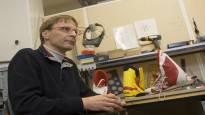Information technology professor Lauri Kettunen quietly conducted an experiment, the results of which changed the measurement of ski jumping suits.
– When something possible is claimed to be impossible, it provokes the twisting of the matter.
Sitting on the board of the Finnish Ski Federation as a representative of hill jumping and combined Lauri Kettunen know about numbers, technology and how to combine them.
Kettunen is a professor of information technology whose current employer is the University of Jyväskylä. He decided to live out his initial quote in January 2021, when the discussion about ski jumping suits and their legality was at its hottest.
The then head coach of the Finnish national team Petter Kukkonen had opened a can of worms right at the beginning of the season and earned the wrath of the international ski bosses.
The unnaturally low crotch in the jumpers’ suits was thoroughly examined in the World Cup competitions. The topic was on the surface, especially in Finland.
The Finnish Ski Federation and the ski jumping community were frustrated by the discussion when the Salpausselä World Cup came at the end of January. When the athletes of the combined pair race climbed the hill tower in Lahti, Kettunen followed along.
Kettunen positioned himself in the TV images (the video as the main image of the article) to the left of the jumpers and placed the so-called scanner on the stand. With it, he collected incredible data about jumpsuits.
– The scanner works like a laser radar. It sends a signal at a wavelength invisible to the eye. When the signal is reflected back from the object, the scanner knows at what distance each pixel that was on the cell has been reflected back. This is how you get a depth map of the jumper, Kettunen says.
Kettunen was not alone with his project. The wire from the scanner went up the stairs of the hill tower, past the jumpers, up to the plane, which is operated by an acquaintance of Kettusen who works at the research institute VTT.
The management of the Finnish Ski Federation decided to do the measurements in their own competitions, but did not discuss the matter beforehand with the International Ski Federation FIS.
Kettunen emphasizes that the motive of the Ski Federation was the desire to ensure equal and fair treatment of athletes and to draw attention to the competition for equipping jump suits.
– After I had done the measurements, we showed the material the same evening Ismo Hämäläinen with to the FIS competition representative (Lasse Ottesen).
Hostile reception
The results from Kettusen’s scan were clear: two teams wore suits that were significantly larger than the others. He refuses to name the teams.
– Some had the hem of the suit closer to the knee than to the hip. The differences were really big, which undoubtedly means several meters. We are talking about at least five meters, Kettunen estimates.
Kettunen presented his results at the 2021 FIS spring meeting. He was not praised for his performance.
– For some, the result was shocking. The reaction was understandable, after all they had first said that it was impossible to play around with costumes.
Kettunen says that he has received some criticism from representatives of the sport.
– The representatives of some Ski Federations complained that this should not be done without the permission of the FIS. In the end, they couldn’t deny the results.
The practice changed
The Combined World Cup pairs competition in question took place in Lahti on January 23, 2021.
Despite the initial criticism, the FIS representatives turned their backs quickly. Three years later, Kettusen’s scanning practice is commonplace in both ski jumping and combined.
Kettunen’s test, conducted in complete silence, served as the starting shot. As usual, the answer to the challenges was found in the traditional technology already in use.
– The device in question, i.e. lidar, works on the same principle as the radar of a car’s cruise control, Kettunen says.
